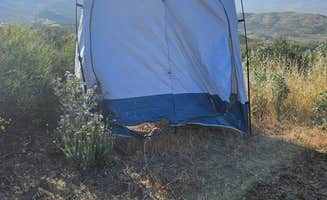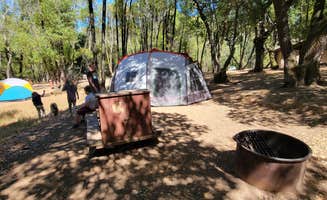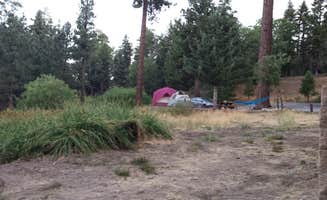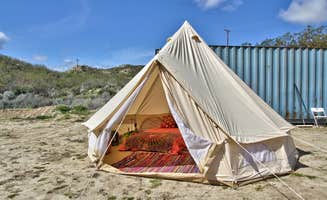Tent camping options near Perris, California range from free primitive sites in the San Bernardino National Forest to established campgrounds with amenities. The region sits at elevations between 1,450 and 8,500 feet, creating significant temperature variations throughout the year. Most tent camping areas require an Adventure Pass when parking at trailheads or forest service roads, with current fees at $5 daily or $30 annually.
What to do
Mountain biking trails: Keller Peak area features challenging rides for experienced cyclists with routes extending through pine forests and rock formations. One camper mentioned, "Bike trail is fun and a challenge" at Keller Peak Yellow Post Campsites.
Fishing access: Green Valley Lake offers fishing opportunities about 1-2 miles from camping areas with stocked waters, though separate fees apply. A camper reported, "The lake is very clean and has a lot of fish. It is privately owned so you do have to pay to fish or swim, and you pay per person" at Lake Arrowhead - Green Valley Lake Recreation Area.
Hiking opportunities: The region offers trails suitable for day hikes directly from campsites, including routes to fire lookout towers. A visitor noted, "The Romona trail starts/ends directly behind the washhouse" at Tool Box Springs Yellow Post Campground, providing immediate access to wilderness exploration.
What campers like
Privacy between sites: The best tent camping near Perris, California often features well-spaced sites that provide seclusion. A camper at Thomas Hunting Grounds Yellow Post Sites shared, "Beautiful, private, and secluded. The campgrounds were wonderful," highlighting the isolation many seek.
Wildlife encounters: The natural setting allows for observation of local fauna in camp areas. At China Camp State Park Campground, a visitor experienced, "Lots of wildlife! A coyote walked right by us. Brave raccoons," providing opportunities for nature viewing.
Night sky viewing: Higher elevation sites offer excellent stargazing due to reduced light pollution. A camper almost didn't want to share their find: "I almost want to give this a 1 star review, just to keep it to myself a little longer... Listen to great horned owls while taking in the views!" at Thomas Hunting Grounds Yellow Post Sites.
What you should know
Vehicle requirements: Many primitive sites require high clearance or 4WD vehicles to access. As one camper warned about Tool Box Springs Yellow Post Campground, "Without a high clearance vehicle, it took me an hour and a half to go six miles up, and still scraped and almost got stuck."
Temperature fluctuations: Higher elevations experience significant cold even in summer months. A visitor to Keller Peak reported, "Weather is definitely colder than in the valley, got snow overnight in mid May" despite the region's reputation for warmth.
Insect activity: Some locations experience seasonal insect problems. A camper shared their experience: "This site would've been perfect, and I mean perfect, but the flies were unbearable. I planned to stay two nights but I couldn't make it past the next morning."
Water availability: Most primitive sites lack water sources, requiring campers to bring all needed water. When visiting Green Valley Lake Recreation Area, plan for approximately 1 gallon per person per day for cooking and drinking.
Tips for camping with families
Site selection for kids: Choose established campgrounds with facilities when camping with children. A parent shared at Yucaipa Regional Park, "Great tent camping facilities, privacy from neighbors, access to Zanja Peak Trail head, 3 lakes for fishing, water park during the summer, and friendly helpful staff."
Activity planning: Look for campgrounds with built-in recreation options to keep children engaged. One family mentioned, "This is your typical regional park Campground. There's a lot to do here, including fishing, playgrounds, and even a waterpark in the summer," at Yucaipa Regional Park.
Safety considerations: Select sites away from steep drop-offs or difficult terrain when with small children. A parent noted, "There's no larger wildlife, like bears, so less stressful when you have pets or kids. Plenty of space to bring bikes and ride around."
Tips from RVers
Site accessibility: Many forest roads leading to yellow post sites have clearance restrictions. A camper with an unconventional setup shared, "We're usually full-time boondockers, and this was the first time we've paid for an RV park... Most private RV spots discriminate against Skoolies, but [Yucaipa Regional Park] didn't seem to care."
Pad sizes: Research concrete pad dimensions before arrival to ensure adequate space for larger rigs. An RVer noted, "Excellent campground. Well maintained. Large concrete pads that can handle any rig," at Yucaipa Regional Park.
Alternative vehicles: Some campers successfully use smaller vehicles for camping. One creative visitor explained, "I converted my Honda Fit into a camper for mine and my pup camping adventures. This was our test location. The drive was extremely easy with a couple of rocky areas that made me slow down to 5mph."













